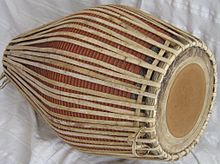Khol (drum)
Khol is a double-skinned double-cone drum in north and east India . The khol is also known as mrdanga ("clay body"), but differs from the South Indian mridangam in terms of its design and playing style .
Its main area of distribution is in Bengal , and it is played in Assam and Orissa . A slimmer design of this type of drum is the pung in Manipur , the north Indian pakhawaj and the Nepalese pashchima are similarly bulged .
The approximately 54 centimeter long drum body of the khol is made of baked clay and has the shape of a double cone. Two different sized cowhide skins are attached with leather laces . The high skin ( dahine ) has a diameter of about 9 cm, the bass skin ( bahine ) of 20 cm. The skins are two-ply. The lower layer is provided with a voice paste , the upper skin is cut out except for a ring. There is also a modern variant made of fiberglass instead of clay.
The khol is played with the fingers of both hands. The player usually hangs the instrument around his neck with a strap or puts it in front of him when playing. The deep fur is played by a right-handed person with the left hand. The sound of the high head is high and piercing.
The khol has been the main instrument for accompanying the religious chants Kirtan and Bhajan in Bengal for centuries and is used in folk music.
literature
- Alastair Dick: Khol . In: Grove Music Online, May 28, 2015
Web links
- KKSongs Khol Guide . (Description and practice units)

